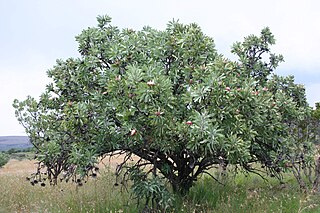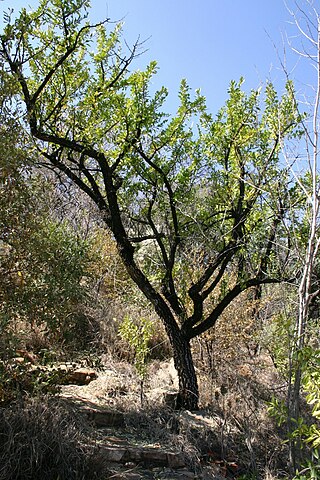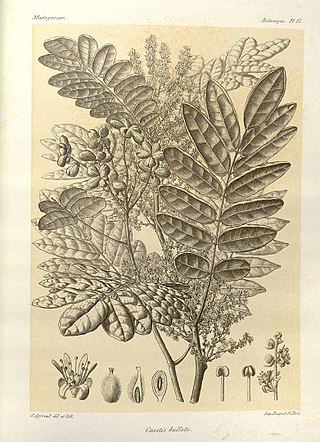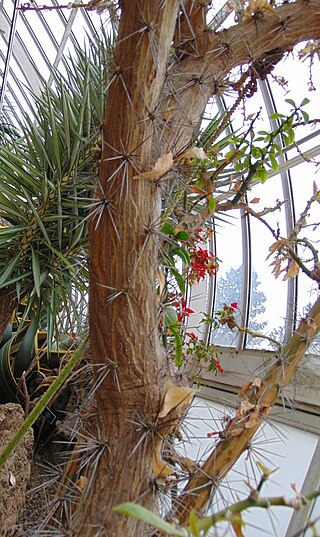
Hazels are plants of the genus Corylus of deciduous trees and large shrubs native to the temperate Northern Hemisphere. The genus is usually placed in the birch family Betulaceae, though some botanists split the hazels into a separate family Corylaceae. The fruit of the hazel is the hazelnut.

Aralia spinosa, commonly known as devil's walking stick, is a woody species of plant in the genus Aralia, family Araliaceae, native to eastern North America. The various names refer to the viciously sharp, spiny stems, petioles, and even leaf midribs. It has also been known as Angelica-tree.

Zanthoxylum clava-herculis, the Hercules' club, Hercules-club, pepperwood, or southern prickly ash, is a spiny tree or shrub native to the southeastern United States. It grows to 10–17 m tall and has distinctive spined thick, corky lumps 2–3 cm long on the bark. The leaves are glabrous and leathery, pinnately compound, 20–30 cm long with 7-19 leaflets, each leaflet 4–5 cm long. The flowers are dioecious, in panicles up to 20 cm long, each flower small, 6–8 mm diameter, with 3-5 white petals. The fruit is a two-valved capsule 6 mm diameter with a rough surface, and containing several small black seeds. The tree has also been called Z. macrophyllum. The genus name is sometimes spelled Xanthoxylum.

Ziziphus nummularia, commonly known as wild jujube or jhahrberi in Hindi, is a species of Ziziphus native to the Thar Desert of western India and southeastern Pakistan, south Iran, Afghanistan, Lebanon and Zimbabwe. Ziziphus nummularia is a shrub up to 6 metres (20 ft) or higher, branching to form a thicket. The leaves are rounded like those of Ziziphus jujuba but differ from those in having a pubescence on the adaxial surface. The plant is commonly found in arid areas, hills, plains, and agricultural fields.

Bursaria is a genus of eight species of flowering plants in the family Pittosporaceae and is endemic to Australia. They are shrubs or slender trees, often with spiny branches and have simple leaves, relatively small flowers with five sepals, five petals and five stamens, and fruit that is a flattened, thin-walled capsule.

Protea caffra, native to South Africa, is a small tree or shrub which occurs in open or wooded grassland, usually on rocky ridges. Its leaves are leathery and hairless. The flower head is solitary or in clusters of 3 or 4 with the involucral bracts a pale red, pink or cream colour. The fruit is a densely hairy nut. The species is highly variable and has several subspecies.

Gymnosporia is an Old World genus of plants, that comprise suffrutices, shrubs and trees. It was formerly considered congeneric with Maytenus, but more recent investigations separated it based on the presence of achyblasts and spines, alternate leaves or fascicles of leaves, an inflorescence that forms a dichasium, mostly unisexual flowers, and fruit forming a dehiscent capsule, with an aril on the seed. It is dioecious, with male and female flowers on separate plants.
Gymnosporia dhofarensis is a species of plant in the family Celastraceae and is found in Oman and Yemen. It is an intricately branched spiny shrub or small tree with its leaves arranged alternately or clustered on short shoots. The flowers have white or cream petals and the fruit are purple or red. It is threatened by habitat loss.

Cuttsia viburnea is a shrub or bushy tree which has toothed leaves and panicles of white flowers, and that is endemic to eastern Australia. It is sometimes called silver-leaved cuttsia, and confusingly also native elderberry, honey bush or native hydrangea. C. viburnea is the only species assigned to the genus Cuttsia.

Gymnosporia heterophylla, the common spike-thorn, is a small, hardy, deciduous African tree up to 5m tall, occurring in rocky places with a wide distribution from Ethiopia, the Sudan and the Congo, south to the Cape Province and west to Angola and Namibia, as well as the neighbouring islands of Madagascar and Saint Helena, with a closely related species from Mauritius.

Alchornea ilicifolia, commonly known as the native holly, is a bush of eastern Australia. It grows in or on the edges of the drier rainforests in coastal parts of New South Wales and Queensland.

Pereskia aculeata is a scrambling shrub in the family Cactaceae. Common names include Barbados gooseberry, blade-apple cactus, leaf cactus, rose cactus, and lemonvine. It is native to tropical America. The leaves and fruits are edible, containing high quantities of protein, iron and other nutrients, and it is a popular vegetable in parts of the Brazilian state of Minas Gerais under the name of ora-pro-nóbis.

Carpodetus serratus is an evergreen tree with small ovate or round, mottled leaves with a toothy margin, and young twigs grow zig-zag, and fragrant white flowers in 5 cm panicles and later black chewy berries. It is an endemic of New Zealand. Its most common name is putaputāwētā which means many wētā emerge - referring to the nocturnal Orthoptera that live in holes in the trunk of this tree made by Pūriri moth caterpillars. Regional variations on the name also refer to this insect that lives and feeds on it such as kaiwētā, and punawētā. The tree is also sometimes called marbleleaf. It is found in broadleaf forest in both North, South and Stewart Islands. It flowers between November and March, and fruits are ripe from January to February.

Psychotria capensis, the bird-berry, is a southern African evergreen shrub or small tree. It belongs to a genus which is used medicinally in many regions, 'Psychotria' being from the Greek for 'rejuvenating', in reference to the healing properties of certain species. Kew lists some 2,000 species of Psychotria growing throughout the warmer regions of both hemispheres, but only two of them occur in southern Africa, namely P. capensis and P. zombamontana.

Cnestis polyphylla, or itch pod, is a liane or scrambling shrub belonging to the family Connaraceae and occurring south from Kenya in East Tropical Africa through Mozambique and Zimbabwe to Southern Africa where it is found in coastal and escarpment forest in Limpopo, Mpumalanga, Eswatini and KwaZulu-Natal, and further south to the Eastern Cape. It also grows on the Indian Ocean islands of Madagascar, Mauritius and Réunion. The genus has at least 13 species with many still unresolved. They are distributed mainly in tropical Africa and nearby islands, but extend to SE Asia and China.
Balanites glabra is a species of tree or shrub, classified either as a member of the Zygophyllaceae or the Balanitaceae. This tree is native to East Africa.

Gymnosporia buxifolia is a species of plant in the bittersweet family (Celastraceae) native to southern Africa. It is commonly known as the pioneer spike-thorn or common spike-thorn. It ranges from Angola and Mozambique to South Africa.
Drypetes gerrardii is a species of small tree or large shrub in the family Putranjivaceae. Common names include forest ironplum, bastard white ironwood, and forest ironwood. It is native to tropical and subtropical central and eastern Africa. It was first described in 1920 by the English botanist John Hutchinson, who named it after the English botanist William Tyrer Gerrard who collected plants and seeds in southern Africa in the 1860s.

Rhodocactus nemorosus is a species of flowering plant in the cactus family Cactaceae, native to southern Brazil, Paraguay, Uruguay and northeast Argentina. Like all species in the genus Rhodocactus and unlike most cacti, it has persistent leaves. It was first described by Nicolás Rojas Acosta in 1897 as Pereskia nemorosa, and transferred to Rhodocactus in 2016.

Itoa orientalis is a species of flowering plants belonging to the family Salicaceae. An evergreen tree from China and Vietnam, and cultivated as an ornamental tree.






















